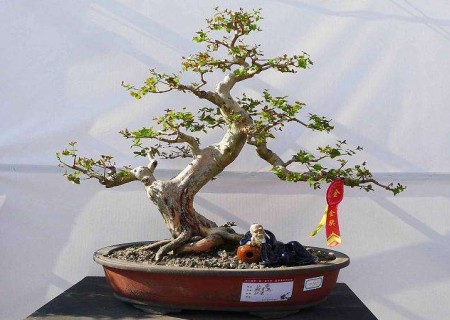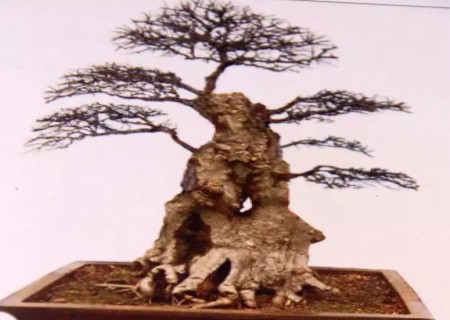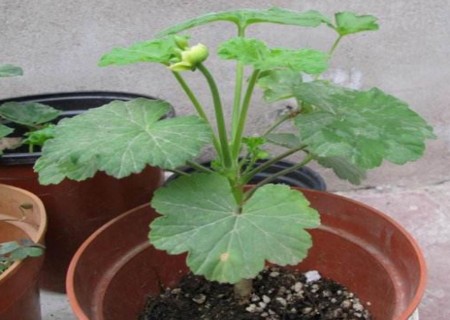How to cut dry and store branches on bonsai stump
The tree stump bonsai shapes the branches mainly to create beautiful lines. However, in practice, we also need to use a variety of artistic techniques to play out, try to let the branches cadence, swing up full of rhythm, so that we can make the so-called "lines" more aesthetic. The extension of the branches should be changed from multiple angles, soft and hard angles, arc curves combined, multi-curved, appropriate length, so that the lines of bonsai naturally smooth and varied, highlighting the strength.

The beauty of the branch layout and lines of the bonsai tree can only be completed after long-term modification and shaping in daily maintenance management. We should proceed step by step in the process of operation, so as to be closer to or achieve our expected design conception, and to continuously improve the pursuit of artistic taste and the value embodiment of the realm. In this respect, Lingnan potted landscape trunk storage method can best reflect. Although the method of cutting off the trunk and storing branches is very time-consuming, it can better reflect the technical skills and artistic level of the creator. Moreover, by not only cutting branches and pruning, but also promoting plant metabolism, it is more conducive to plant growth, so that the bud forcing effect is more prominent, so that the plant can achieve gorgeous transformation, which should be an important means of making bonsai trees.
The pruning and branch storage we are talking about here does not rely solely on shearing and cutting. In fact, it can also be completed by means of tying, and we can only adopt the method when the plant is cultivated to a certain extent. The operation steps are as follows: new pile cultivation-trunk cutting and branch storage-mainly storing; combination of shearing and tying-firstly tying and then shearing-mainly shearing.
First of all, we need to cultivate the old piles of plants for a period of time, so that the stumps have a certain bearing capacity before they can be cut off, and we cannot be eager for quick success, otherwise it will result in a situation of double success and half success. Especially the first branch, must give enough time to cultivate, can not be too thin, but also can not be too thick. If the primary branch is too small, it is difficult to grow it strong after cutting; if the primary branch is too strong, it will cause a large wound section and will not be coordinated with the trunk. For the secondary branches, tertiary branches... we have to control the heat, do it properly, so that the branches are more coordinated, more reasonable, and more beautiful.
Of course, the combination of shear and tie cannot be too focused on which side, especially the branches that have not been properly tied are difficult to show the natural beauty, because it is generally difficult for the branches to bend after lignification. If imposed, it is not only difficult to achieve the desired effect, but also easy to break the branches, causing irreparable damage to the plants. Therefore, we need to properly twist and bend the branches before lignification, and cut them after the plants are finalized. The beauty of bonsai branches is more accomplished through winding and bending techniques. Therefore, through the combination of cutting and winding to create bonsai, not only will shorten the molding time of the work but also improve its ornamental value.
When the tree bonsai becomes a mature tree, its branches will continue to extend, the crown will become more and more bloated, and the inner branches will dry up year by year due to less and less light. At this time, we need to cut the terminal branches in time, trim off the dead branches, and continue to cultivate, so that the whole bonsai works can be restored and maintained in a good posture.
Time: 2019-06-08 Click:
- Prev

Illustration of the method of storing branches in bonsai
As we all know, the styling beauty of bonsai needs to be done by pruning, which is the most commonly used means, but before pruning, we have to keep the branches of the plant strong. So, how do bonsai grow and grow branches? Next, the editor will share with you an article on how to store branches in bonsai.
- Next

Illustration of cutting Propagation methods of Pelargonium
As the geranium is a stem semi-succulent plant, the plant contains a lot of water, so it is easy to have rotten roots when cutting, thus affecting the survival rate of cutting. In view of this, combined with practical experience, the measures of re-pruning of geranium plants after anthesis were improved.
Related
- Fuxing push coffee new agricultural production and marketing class: lack of small-scale processing plants
- Jujube rice field leisure farm deep ploughing Yilan for five years to create a space for organic food and play
- Nongyu Farm-A trial of organic papaya for brave women with advanced technology
- Four points for attention in the prevention and control of diseases and insect pests of edible fungi
- How to add nutrient solution to Edible Fungi
- Is there any good way to control edible fungus mites?
- Open Inoculation Technology of Edible Fungi
- Is there any clever way to use fertilizer for edible fungus in winter?
- What agents are used to kill the pathogens of edible fungi in the mushroom shed?
- Rapid drying of Edible Fungi

